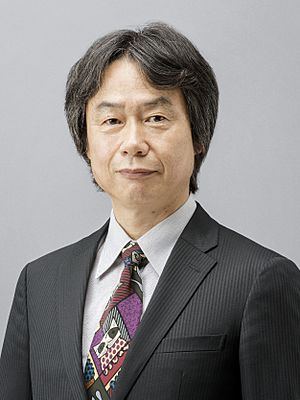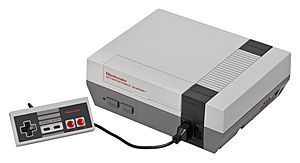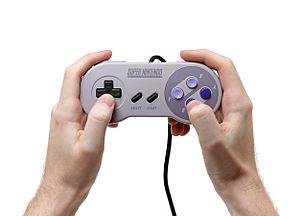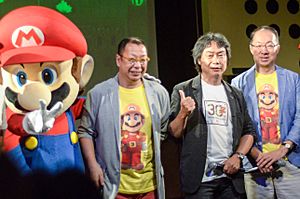Shigeru Miyamoto facts for kids
Quick facts for kids
Shigeru Miyamoto
|
|
|---|---|
| 宮本 茂 | |

Miyamoto in 2015
|
|
| Born | November 16, 1952 Sonobe, Kyoto, Japan
|
| Alma mater | Kanazawa College of Art |
| Occupation |
|
| Employer | Nintendo (1977–present) |
|
Notable work
|
|
| Title |
|
| Spouse(s) | Yasuko Miyamoto |
| Children | 2 |
| Awards | AIAS Hall of Fame Award (1998) BAFTA Fellowship (2010) Person of Cultural Merit (2019) |
| Signature | |
 |
|
Shigeru Miyamoto (Japanese: 宮本 茂, Hepburn: Miyamoto Shigeru, born November 16, 1952) is a famous Japanese video game designer and producer. He works at Nintendo and has been a top executive there since 2002. Many people think he is one of the most important and creative game designers ever.
Miyamoto created some of the most loved and best-selling game series of all time. These include Mario, The Legend of Zelda, Donkey Kong, Star Fox and Pikmin. Over 1 billion copies of games from these series have been sold!
Miyamoto was born in Sonobe, Kyoto, Japan. He studied at Kanazawa Municipal College of Industrial Arts. He first wanted to be a manga artist, but then became interested in video games. In 1977, he joined Nintendo. He impressed the company's president, Hiroshi Yamauchi, with his toy ideas.
He helped create art for the arcade game Sheriff. Later, he was asked to design a new arcade game. This led to the very popular 1981 game Donkey Kong.
Miyamoto's games Super Mario Bros. (1985) and The Legend of Zelda (1986) were huge hits. They helped the Nintendo Entertainment System become super popular. His games have been major titles for every Nintendo video game console, from old arcade machines to today's systems.
He used to lead Nintendo's Entertainment Analysis & Development (EAD) team. This team made many Nintendo games. He also played a big part in creating other famous games like Pokémon Red and Blue (1996) and Metroid Prime (2002). After Nintendo's president, Satoru Iwata, passed away in 2015, Miyamoto became a "Creative Fellow." In this role, he gives expert advice to game directors.
Contents
Early Life and Inspiration
Shigeru Miyamoto was born on November 16, 1952, in Sonobe, Japan. His parents were not rich, and his father taught English.
When he was young, Miyamoto loved exploring nature near his home. He found a cave and bravely went inside after thinking about it for days. These adventures in the Kyoto countryside later inspired his games, especially The Legend of Zelda.
In the early 1970s, Miyamoto earned a degree in industrial design. He loved manga and first hoped to become a professional manga artist. But then, he became interested in video games. The 1978 arcade hit Space Invaders made him want to join the video game industry.
Creating Iconic Games
Arcade Beginnings: Donkey Kong
In the 1970s, Nintendo was a small Japanese company. They sold playing cards and other fun items. Miyamoto's father helped him get an interview with Nintendo's president, Hiroshi Yamauchi. Miyamoto showed off some of his toy ideas and was hired in 1977.
Miyamoto helped create art for the arcade game Sheriff. Later, Nintendo needed a new game for their unsold Radar Scope arcade machines. The president asked Miyamoto to create a new game for them. Miyamoto joked that "no one else was available" for the job.
Miyamoto came up with many characters and story ideas. He finally decided on a love triangle story. It was about a gorilla, a carpenter, and a woman. He wanted it to be like the rivalry between Bluto and Popeye for Olive Oyl. The ape became the main character's pet. Miyamoto also got ideas from "Beauty and the Beast" and the 1933 movie King Kong.
Miyamoto had big hopes for his new game. He imagined characters of different sizes and movements. He wanted the game to have multiple stages. The programming team thought this was too hard, but they made it work. When the game was tested in America, the sales manager didn't like it. It was very different from the popular maze and shooter games of that time.
American staff named the characters. The woman was called "Pauline." The playable character, first named "Jumpman," became "Mario." This was after Mario Segale, the warehouse landlord. The game was named Donkey Kong.
Donkey Kong was a huge success! This led Miyamoto to work on sequels like Donkey Kong Jr. (1982) and Donkey Kong 3 (1983). In his next game, he gave Mario a brother, Luigi. He named the new game Mario Bros.. Miyamoto changed Mario's look to be a plumber instead of a carpenter. He thought New York City's "sewage pipes" would be a great setting.
NES Era: Super Mario Bros. and The Legend of Zelda

When Nintendo released its first home console, the Family Computer (known as the NES in North America), Miyamoto created two of its most popular games. These were Super Mario Bros. (a sequel to Mario Bros.) and The Legend of Zelda.
In both games, Miyamoto focused on how fun the game was to play, not just on getting high scores. Super Mario Bros. was a side-scrolling game where players ran, jumped, and dodged enemies. It combined Miyamoto's ideas from games like Donkey Kong and Excitebike. He wanted a game with an expansive world, aboveground and underground levels, and colorful backgrounds.
The Legend of Zelda was different. It used nonlinear gameplay, meaning players could explore freely. They had to solve riddles and puzzles. The world felt huge and endless, offering "choice and depth never seen before." Miyamoto wanted players to feel connected to the game world. He got his ideas from exploring fields, woods, and caves around Kyoto as a boy. He said, "When I was a child, I went hiking and found a lake. It was quite a surprise for me to stumble upon it." This feeling of discovery inspired Zelda.
Miyamoto also worked on other NES games, including Ice Climber and Kid Icarus. He made sequels for both Super Mario Bros. and The Legend of Zelda. Super Mario Bros. 3 took over two years to make. It added many new features, like costumes with different abilities. Miyamoto based Bowser's children on seven of his programmers to honor their hard work.
SNES and Nintendo 64: 3D Worlds
Nintendo's research teams joined to form Nintendo Entertainment Analysis & Development (Nintendo EAD). Miyamoto eventually led this group. He worked on many games for the SNES, including F-Zero and Star Fox. For Star Fox, Nintendo added a special chip called the Super FX chip. This helped the SNES handle early 3D graphics.
Miyamoto also produced two big Mario games for the SNES. Super Mario World was a launch game and introduced the character Yoshi. The second, Super Mario RPG, was a partnership with Square. It took almost a year to create its graphics.
He also created The Legend of Zelda: A Link to the Past for the SNES. This game brought back the top-down view and introduced elements like the Master Sword and parallel worlds, which are still in Zelda games today.
Shigeru Miyamoto also guided Satoshi Tajiri during the creation of Pokémon Red and Green (known as Pokémon Red and Blue in English). He helped with ideas like trading Pokémon between players. Pokémon became one of the most popular entertainment series in the world.
For the Nintendo 64, Miyamoto made several games, mostly from his existing series. His first game for the new system was Super Mario 64. This game was a pioneer in 3D game design. Miyamoto and his team spent months deciding on the best camera view and level layout. He also helped design the Nintendo 64 controller while making Super Mario 64.
After learning about the Nintendo 64 from Super Mario 64 and Star Fox 64, Miyamoto produced The Legend of Zelda: Ocarina of Time. This game's engine was based on Super Mario 64's. It was a new challenge for the team to make a 3D Zelda game. Miyamoto also produced a sequel, The Legend of Zelda: Majora's Mask.
Miyamoto worked on many Mario spin-off games for the Nintendo 64, like Mario Kart 64 and Mario Party.
GameCube, Wii, and DS Innovations
Miyamoto produced several games for the GameCube, including Luigi's Mansion. He also continued to make Mario spin-offs. He produced the 3D game series Metroid Prime. He developed Pikmin and Pikmin 2, inspired by his own gardening experiences. He also worked on new games for Star Fox, Donkey Kong, F-Zero, and The Legend of Zelda on both GameCube and Game Boy Advance.
He helped with many games on the Nintendo DS, including a remake of Super Mario 64 called Super Mario 64 DS. He also created Nintendogs, a new series based on his own dogs.
Miyamoto played a big part in creating the Wii. This console made motion control gaming very popular. Its launch game, Wii Sports, showed off the new controls. Miyamoto also produced other Wii series games, like Wii Fit. He was inspired to create Wii Fit to encourage families to talk and bond.
At E3 2004, Miyamoto revealed The Legend of Zelda: Twilight Princess. He even dressed up as Link! This game was a launch title for the Wii and the first Zelda game to use motion controls. He also helped with The Legend of Zelda: Skyward Sword, which had even more accurate motion controls. He produced two Zelda games for the Nintendo DS, The Legend of Zelda: Phantom Hourglass and The Legend of Zelda: Spirit Tracks. These were the first Zelda games to use touch screen controls.
Miyamoto produced three major Mario games for the Wii: Super Mario Galaxy, New Super Mario Bros. Wii, and Super Mario Galaxy 2.
Recent Projects: Wii U, 3DS, and Switch
In recent years, Miyamoto has taken on more of a supervisory role. He was a General Producer for games like Luigi's Mansion: Dark Moon and Star Fox Zero. This means he gives feedback and guidance to game directors.
After Nintendo president Satoru Iwata passed away in 2015, Miyamoto became an acting Representative Director. Later, he was appointed "Creative Fellow." In this role, he continues to provide expert advice and support to Nintendo's game development.
In 2018, it was announced that Miyamoto would be a producer for The Super Mario Bros. Movie. This movie is based on the Mario games and was made by Illumination.
Miyamoto was also very involved in designing and building Super Nintendo World. This is a themed area at Universal Studios Japan, Universal Studios Hollywood, and Universal Epic Universe. He oversaw the design of the land and its rides. He even gave a tour of parts of the land in a Nintendo Direct video in December 2020.
Miyamoto's Game Design Ideas
Miyamoto and Nintendo don't use focus groups to test games. Instead, Miyamoto figures out if a game is fun for himself. He believes if he enjoys it, others will too. He said, "Not to make something sell, something very popular, but to love something, and make something that we creators can love." He wants players to feel the same excitement the developers felt.
He tests games with friends and family. He encourages younger developers to think about new players. For example, he asks them to try playing with their non-dominant hand.
Miyamoto doesn't focus on super realistic graphics. He cares more about how the game plays. He focuses on the choices and challenges in the game. He wants to create "something unique and unprecedented." He prefers games to be interactively fun rather than having long movie scenes. He likes to change his games right up until they are finished.
Impact and Recognition
Time magazine called Miyamoto "the Spielberg of video games" and "the father of modern video games." The Daily Telegraph said he is "possibly the most important game designer of all time." Many of Miyamoto's games have introduced new ideas or made existing ones much better. His games have received amazing reviews, with some being called the greatest games ever.
Miyamoto's games have also sold incredibly well. They are some of the bestselling games on Nintendo consoles and in history. By 1999, his games had sold 250 million copies and made billions of dollars.
The New Yorker said Miyamoto was key to creating the game series that made Nintendo consoles so popular. They called him Nintendo's "guiding spirit." Next Generation magazine listed him as one of the "75 Most Important People in the Games Industry of 1995."
Influence on the Industry
Miyamoto's first big arcade hit, Donkey Kong, was very influential. It led to many other games where players ran, jumped, and climbed. This type of game became known as "platform" games. Donkey Kong also used short scenes to tell a story, which was new for games at the time.
His most famous game, Super Mario Bros., "created an industry or brought a sleeping one back to life." The Daily Telegraph said it "set the standard for all future videogames." It also made the side-scrolling video game genre very popular. Mario became the first video game hero, as famous as Mickey Mouse.
GameSpot named The Legend of Zelda one of the 15 most influential games ever. It was an early example of open world and nonlinear gameplay. It also introduced battery backup saving, which set the stage for many future adventure and role-playing games.
Super Mario 64 defined how 3D games should be designed. It was especially important for its dynamic camera system and analog controls. The Legend of Zelda: Ocarina of Time introduced features like a target lock system and context-sensitive buttons. These are now common in 3D adventure games.
The Wii, which Miyamoto helped design, was the first wireless motion-controlled video game console.
Critical and Commercial Success
Miyamoto's games have received amazing reviews. Many are considered among the greatest games of all time.
Games in Miyamoto's The Legend of Zelda series have been highly praised. A Link to the Past is seen as one of the greatest video games ever. Ocarina of Time is widely considered by critics and players to be one of the greatest video games ever made. Guinness World Records listed Ocarina of Time as the highest-rated video game in history.
Super Mario Bros. is also seen as one of the best video games of all time. Super Mario 64 is praised as one of the most revolutionary games ever.
Super Mario Galaxy and Super Mario Galaxy 2 are the highest-rated games for the Wii.
More than 1 billion copies of games from Miyamoto's series have been sold.
His Mario series is the best-selling video game series of all time, with over 800 million units sold. Super Mario Bros. is the sixth best-selling video game of all time. It was the bestselling video game for over 20 years until Wii Sports surpassed it. Super Mario World was the bestselling game for the Super Nintendo Entertainment System. Super Mario 64 was the bestselling Nintendo 64 game. The Mario series continues to sell millions of copies on newer consoles like the Nintendo Switch.
The original The Legend of Zelda game is the fifth-bestselling game for the Nintendo Entertainment System. The Wind Waker is the fourth bestselling GameCube game. Twilight Princess was very successful. The Legend of Zelda: Breath of the Wild sold over 32 million copies on the Switch. The Legend of Zelda: Tears of the Kingdom sold over 21 million units. Both are top sellers for the Nintendo Switch.
The Mario Kart series is the most successful racing game series ever. Mario Kart games are usually among the bestselling games for their consoles. Mario Kart 8 Deluxe is the bestselling game on the Nintendo Switch as of July 2025.
Miyamoto produced Wii Sports, another of the bestselling games of all time. Wii Fit, also designed by Miyamoto, was the third bestselling console game not sold with a console.
Outside of video games, Miyamoto produced The Super Mario Bros. Movie. This movie became the third-highest-grossing animated movie of all time. It is also the highest-grossing film based on a video game series by a huge amount.
Awards and Honors
Will Wright, a famous game designer, said Miyamoto "approaches the games playfully... And he approaches things from the players' point of view, which is part of his magic."
In 1998, Miyamoto was the first person to be added to the Academy of Interactive Arts and Sciences' Hall of Fame. In 2006, he was made a "Chevalier" (knight) by the French Minister of Culture.
TIME Asia featured Miyamoto in their "60 Years of Asian Heroes" in 2006. He was also chosen as one of Time Magazine's 100 Most Influential People of the Year in 2007 and 2008. At the Game Developers Choice Awards in 2007, Miyamoto received the Lifetime Achievement Award.
In a survey of game developers, 30% chose Miyamoto as their "Ultimate Development Hero." In 2010, he was made a Fellow of BAFTA. In 2012, Miyamoto was the first interactive creator to receive Spain's highest honor, the Prince of Asturias Award.
Miyamoto received Japan's Person of Cultural Merit award in 2019. He was the first person from the video game industry to get this honor.
Personal Life
Miyamoto is married to Yasuko and they have two children. His children played video games when they were young, but he also encouraged them to do outdoor activities. He can speak some English, but he prefers to speak Japanese in interviews.
Miyamoto usually doesn't sign autographs because he would be asked too often. He also doesn't appear on Japanese television much to avoid being recognized. More foreign tourists recognize him than Japanese people.
Miyamoto is ambidextrous, meaning he can use both hands well. He usually favors his left hand. This is why his characters Mario and Link were designed to be left-handed.
Miyamoto doesn't spend much time playing video games in his free time. He prefers to play the guitar, mandolin, and banjo. He loves bluegrass music. In a 2016 interview, Miyamoto said he started gardening with his wife, which influenced some of his games. He has a Shetland Sheepdog named Pikku, who inspired Nintendogs.
He once said, "Video games are bad for you? That's what they said about rock and roll." A famous quote, "a delayed game is eventually good, but a rushed game is forever bad," is often linked to him. However, fans found out in 2023 that it actually came from Siobhan Beeman, who worked on the Wing Commander series.
Miyamoto enjoys rearranging furniture in his house, even late at night. He also likes to guess the size of objects and then check if he was right. He reportedly carries a measuring tape with him everywhere! In December 2016, Miyamoto showed this hobby on The Tonight Show Starring Jimmy Fallon. He also played the Super Mario Bros. theme on guitar with The Roots on the same show.
Works
Selected Games
| Year | Game Title | Role |
|---|---|---|
| 1979 | Sheriff | Graphic designer |
| 1980 | Space Firebird | |
| 1981 | Donkey Kong | Director, game designer |
| Sky Skipper | Graphic designer | |
| 1982 | Donkey Kong Jr. | Director, game designer |
| Popeye | Game designer | |
| 1983 | Mario Bros. | Director, game designer |
| Donkey Kong 3 | ||
| Baseball | Game designer | |
| 1984 | Tennis | |
| Wild Gunman | Director, game designer | |
| Duck Hunt | ||
| Golf | Game designer | |
| Hogan's Alley | Director, game designer | |
| Devil World | ||
| Excitebike | ||
| 1985 | Kung Fu | |
| Super Mario Bros. | Director, producer, game designer | |
| 1986 | The Legend of Zelda | |
| Super Mario Bros.: The Lost Levels | Director, producer | |
| Volleyball | Producer | |
| 1987 | Zelda II: The Adventure of Link | |
| Yume Kōjō: Doki Doki Panic | ||
| Shin Onigashima | ||
| 1988 | Super Mario Bros. 3 | Director, producer, game designer |
| 1989 | Mother | Producer |
| 1990 | F-Zero | |
| Super Mario World | ||
| Pilotwings | ||
| 1991 | The Legend of Zelda: A Link to the Past | |
| 1992 | Wave Race | |
| Super Mario Kart | ||
| 1993 | Star Fox | Producer, game designer |
| Kirby's Adventure | Producer | |
| The Legend of Zelda: Link's Awakening | ||
| 1994 | Donkey Kong | |
| Kirby's Dream Course | ||
| 1995 | Kirby's Dream Land 2 | |
| Yoshi's Island | ||
| BS Zelda no Densetsu | Designer | |
| 1996 | Pokémon Red and Blue | Producer |
| Super Mario RPG | ||
| Kirby Super Star | ||
| Pilotwings 64 | ||
| Super Mario 64 | Director, producer | |
| Mole Mania | Producer | |
| Wave Race 64 | ||
| Mario Kart 64 | ||
| 1997 | Star Fox 64 | Producer, game designer |
| 1998 | 1080° Snowboarding | Producer |
| F-Zero X | ||
| The Legend of Zelda: Ocarina of Time | Producer, supervisor | |
| 1999 | Super Smash Bros. | Producer |
| Pokémon Snap | ||
| Pokémon Stadium | ||
| 2000 | The Legend of Zelda: Majora's Mask | Producer, supervisor |
| Paper Mario | Producer | |
| Pokémon Crystal | ||
| Pokémon Stadium 2 | ||
| 2001 | Mario Kart: Super Circuit | |
| Luigi's Mansion | ||
| Pikmin | Producer, original concept | |
| Super Smash Bros. Melee | Producer | |
| 2002 | Magical Vacation | |
| Eternal Darkness | ||
| Super Mario Sunshine | ||
| Star Fox Adventures | ||
| Metroid Prime | ||
| The Legend of Zelda: Four Swords | General producer | |
| The Legend of Zelda: The Wind Waker | Producer | |
| 2003 | Kirby Air Ride | |
| F-Zero GX | ||
| Mario Kart: Double Dash | ||
| Mario & Luigi: Superstar Saga | ||
| 2004 | The Legend of Zelda: Four Swords Adventures | |
| Pikmin 2 | ||
| Paper Mario: The Thousand-Year Door | ||
| Donkey Kong Jungle Beat | General producer | |
| 2005 | Star Fox: Assault | Producer |
| Nintendogs | General producer, original concept | |
| 2006 | The Legend of Zelda: Twilight Princess | Producer |
| Wii Sports | General producer | |
| 2007 | Super Mario Galaxy | Producer, game design concept |
| Wii Fit | Designer, general producer | |
| 2010 | Super Mario Galaxy 2 | General producer |
| 2011 | The Legend of Zelda: Skyward Sword | |
| Steel Diver | Designer, general producer | |
| 2013 | Pikmin 3 | General producer |
| Super Mario 3D World | ||
| The Legend of Zelda: A Link Between Worlds | ||
| 2014 | Captain Toad: Treasure Tracker | |
| 2015 | Super Mario Maker | General producer, original concept |
| 2016 | Star Fox Zero | Supervising director, producer |
| Super Mario Run | Director, producer | |
| 2017 | The Legend of Zelda: Breath of the Wild | General producer |
| Super Mario Odyssey | Executive producer | |
| 2023 | The Legend of Zelda: Tears of the Kingdom | General producer |
| Pikmin 4 |
Other Projects
| Year | Title | Media | Role |
|---|---|---|---|
| 2021 | Super Nintendo World | Theme park | Creative director |
| 2023 | The Super Mario Bros. Movie | Film | Producer |
| 2026 | Super Mario World | Film | Producer |
| 2027 | The Legend of Zelda | Film | Producer |
See also
 In Spanish: Shigeru Miyamoto para niños
In Spanish: Shigeru Miyamoto para niños





